|
I tried to simplify most aspects of shooting/displaying for picture ratios because details can
quickly become overhelming (although quite frankly interesting from a technical point of view).
To let you understand what you should expect on your video system for each mode, I will
add each time a typical 4/3 and 16/9 display sample (without and with zooming).
Jump to:
[Academy Ratio/Video]
[Letterboxed]
[Pan&Scan]
[Open Matte]
[Squeeze]
[PAL+]
[Hi-Vision]
[Others]
 | Academy Ratio / Video [1.33:1] |
-
This is originally the ratio that emerged from the first years of filmed pictures. Directly
linked with the reel frame size, silent movies without sound tracks could be shot in 1.37:1.
Then soundtrack took some more space (double mono, one for backup, that later became stereo)
and cut it down to 1.33:1. Most movies until the 50's were shot in this ratio. This is why TV
sets for the 40 years to come would be manufactured with this "magic" 1.33:1 (= 4/3) picture
size that would give its specific size to all later video standards (NTSC, PAL, SECAM, Beta,
VHS, LD, etc.).
Anything shoot on film with a 1.33:1 ratio should be considered as "Academy Ratio", this
includes TV Series shot on film.
Some movies/programs shot in Academy Ratio: Citizen Kane, Gone with the Wind, X-Files

Academy Ratio / Video | 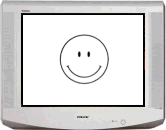
Standard 4/3 | 
Widescreen 16/9
(zooming would cut 25% of the picture) |
(back to top)
 | Letterboxed [1.66:1~2.60:1] |
-
Over the years, movie theaters and producers tried to enhance the experience by adding sound,
color and eventually developping better mechanical camera/optical lenses to allow more pictures
to be filmed and displayed. Since picture was supposed to be immerging and breath-taking, all your
visual area had to be filled, and because your two eyes are horizontaly aligned, the picture
started spreading on the right and left sides.
The film in a movie theater will look as filling the whole screen but the same ratio applied
on a standard TV Set will show the so-called black bars on top and bottom of the screen.
Since a widescreen TV is 16/9 (1.78:1), anything between 1.33:1 and 1.78:1 (typically 1.50:1 to 1.66:1)
will still have grey unused spaces on the lateral side while anything wider than 1.78:1 (typically
1.85:1, 2.00:1, 2.20:1, 2.35:1) will still show some amount of "black bars" even on a widescreen TV.
Some movies shot in 1.85:1: The Godfather, Saving Private Ryan, Aliens

Letterbox 1.85:1 | 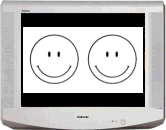
Standard 4/3 | 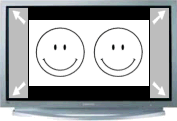
Widescreen 16/9 |  | 
(without and with zoom) |
Some movies shot in 2.35:1: Terminator 2, Star Wars, Fight Club

Letterbox 2.35:1 | 
Standard 4/3 | 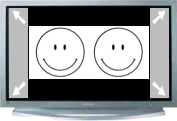
Widescreen 16/9 |  | 
(without and with zoom) |
(back to top)
 | Pan&Scan [1.33:1] |
-
Sadly, most people for a long time were not exactly happy with the fact that they bought a
very expensive TV screen and ended up with black bars eating up as much as almost half the
available space!
One way to get around this on a standard screen was zooming in the picture to fill up the screen,
thus losing image information on both sides and killing director's intented photography and
image composition! Watching 2001 or any Sergio Leone movie in Pan&Scan would likely kill
the artistic and dramatic framing imagined by the director and eventually make some scenes dull
and boring. But at that time OAR (for Original Aspect Ratio)
was not a selling argument. And kids wanted to see it big on the screen, no way they would stand
those awful black bars!

1.85:1 to be zoomed |  | 
1.85:1 in Pan&Scan
(28% of picture lost) | 
Standard 4/3 | 
Widescreen 16/9
(zooming would cut 46% of the original picture) |

2.35:1 to be zoomed |  | 
2.35:1 in Pan&Scan
(46% of picture lost) | 
Standard 4/3 | 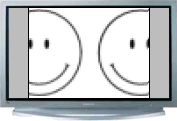
Widescreen 16/9
(zooming would cut 58% of the original picture) |
(back to top)
 | Open Matte [1.33:1] |
-
Open matting could be seen as the opposite of Pan & Scanning. For some programs, the director
had both a letterboxed and a Academy ratio in mind (for theaters in 1.85:1 and later for TV broadcast
and commercial release in 1.33:1). Open matting is actually removing the black bars to show
more information on top and bottom of the screen! Some carefully composed movies will take
advantage of this to keep visual consistency in both modes, but on some of them, you can expect to
see wires, crew members, microphones or camera leading tracks on the floor!
Some movies released in Open Matte: Carrie, Full Metal Jacket

Original 1.85:1
(in Theaters) |  | 
1.33:1 Open Matte
(28% of picture gained) | 
Standard 4/3 | 
Widescreen 16/9 |
(back to top)
 | Anamorphic Widescreen [1.85:1~2.35:1] |
-
Before DVD finally hit the stores all around the world, LaserDisc was already investigating both
HDTV (720p/1080i, Hi-Vision in Japan: see below) and Widescreen TV sets. Research showed
in the 60's that human field of vision was roughly between 5/3 (1.66:1) and 6/3 (2.00:1). Any easy
was to accomodate this ratio range with existing 4/3 equipment was to add 33% horizontal resolution:
4/3 is also 12/9, 12 + 33% = 16, hence 16/9 (1/78:1).
Since there would be period with both 4/3 and 16/9 technologies would live side by side, some
compromises and optimizations were to be invented. One idea was that storing black bars in the disc
was a waste of space and could be used in a smarter way. With 16/9 screens making slowly their way
to the market, it was no more necessary to zoom the picture to fit the screen (enhancing the
picture size but not quality).
The idea of anamorphic transfer was to store, in a 4/3 picture, stretched (or squeezed) information
that would natively fit the 16/9 ratio screen once unstretched (or unsqueezed). This picture is only
intended for 16/9 display and will appear distorted on standard 4/3 displays. This ultimately gives a 33%
increase of the number of line displayed, improving picture quality compared to standard letterboxing.
Some programs available in squeeze mode: Alaska, Gaia's Daughter, Ordinary Europe, Tahiti

Original 1.78:1
(16/9 aspect) |  | 
Actual 1.33:1
(in 4/3, looks distored) | 
Widescreen 16/9 |  | 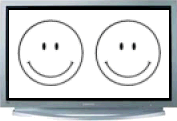
(without and with zoom) |
Some movies available in squeeze mode: Terminator 2, Showgirls (NTSC and PAL), Microcosmos

Original 2.35:1
(16/9 aspect) |  | 
Actual 1.33:1
(in 4/3, looks distored) | 
Widescreen 16/9 |  | 
(without and with zoom) |
(back to top)
 | PAL+ / PAL Plus [1.78:1~2.35:1] |
-
Back in the early 90's, European Broadcaster defined and designed an extension of the PAL
standard that would fit upcoming 16/9 requirements but still keep backward compatibility with
existing PAL TV sets. The idea was to include an extra line (along with extra hidden format
information) every 3 lines making the default 430 lines go up to 574 lines of information.
While very nice for 16/9 display, the titles mastered for PAL+ format were probably not
showing the best display on regular 4/3 display. The resulting display would not dither/adapt
the signal from 4 to 3 lines but rather "forget" to display 1 line every 4 lines of information.
This is one step better than NTSC Squeezed LDs, but still one step below true anamorphic
transfers has found on DVD today.
Movies available in PAL+ mode (Germany): Showgirls, Mikrokosmos, Schlafes Bruder
(back to top)
 | Hi-Vision Widescreen [1.78:1] |
-
Hi-Vision (either in compressed MUSE or uncompressed HDVS) is natively widescreen 16/9.
Any picture shot in Hi-Vision video will be 1.78:1. Movie transfer more than 1.78:1 wide will show
some black bars on top and bottom. If a movie shot in Academy Ratio was released in Hi-Vision, there
would be black bars on the right and left sides. When standard NTSC LaserDiscs were mastered based
on a Hi-Vision tapes, they would be either letterboxed, squeezed or both
(letterboxed on one side and squeezed on the other side). Hi-Vision widescreen is also intended only
for 16/9 screens.
Some movies available in Hi-Vision: Cliffhanger (Hi-Vision, letterboxed, squeezed),
Alaska (Hi-Vision, HDVS, letterboxed/squeezed)

Original 2.35:1
(16/9 aspect) | 
Widescreen 16/9 |
(back to top)
Some more details (Super35, Matting)
-
To be completely honest, Pan&Scan is not always that bad because director knows that simply shooting
2.35:1 will end up in a bad framing on classic 4/3 ratio. One way to accomodate these opposite constraints
has been promoted under the shape of Super35 films (by James Cameron among others). Terminator 2, The Abyss
or Titanic have been shot in Super35 mode which is located somewhere between Pan&Scan and Open Matte.
Frame is shot full 16/9 and will be latter cut (matted) to 2.35:1 (blue rectangle) or 1.33:1 (yellow rectangle)
in different zones. Describing these 4/3 releases as Pan&Scan is not completely accurate but is the closest
choice since information from the theater version is lost on right and left sides.

Original framing
(16/9 aspect) | 
Super35 matting(s) | 
4/3 Result | 
16/9 Result |
When buying a Widescreen DVD of video contents (Live Concerts especially), be careful to check before
that the source material was indeed shot widescreen. Most of the time, just for the sake of putting "Widescreen"
on the cover to please people who just bought an expensive 16/9 TV set, the picture will be eventully matted
from an original 4/3 video. You will end up losing information just for the sake of filling up the screen
of your 16/9 TV screen, which is just as silly as losing information to fill up a 4/3 TV set with Pan&Scan.
This is the exact opposite of "Open Matted", this is "Matted".
One example I know for sure of this (LD full video, DVD matted) is: Peter Gabriel: Secret World Live

Original framing
(4/3 aspect) | 
1.85:1 matting | 
4/3 Result | 
16/9 Result |
(back to top)
| |



